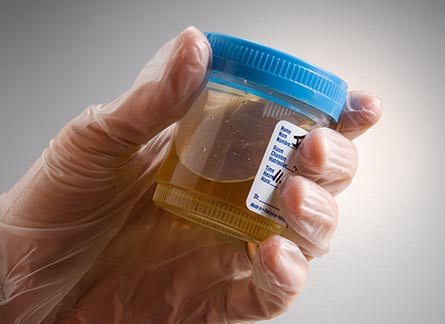Urinalysis - Definition, Preparation and Normal Results
Urinalysis is an array of tests performed on urine and one of the most common methods of medical diagnosis. Urinalysis can reveal diseases that have gone unnoticed because they do not produce striking signs or symptoms. Examples include diabetes mellitus, various forms of glomerulonephritis, and chronic urinary tract infections.
Urine tests are typically evaluated with a reagent strip or dipstick that is briefly dipped into your urine sample. The technician reads the colors of each test and compares them with a reference chart. These tests are semi-quantitative; there can be some variation from one sample to another on how the tests are scored.

Urinalysis
pH : This is a measure of acidity for your urine.
Specific Gravity (SG) : This measures how dilute your urine is. Water would have a SG of 1.000 . Most urine is around 1.010, but it can vary greatly depending on when you drank fluids last, or if you are dehydrated.
Glucose : Normally there is no glucose in urine. A positive glucose occurs in diabetes. There are a small number of people that have glucose in their urine with normal blood glucose levels, however any glucose in the urine would raise the possibility of diabetes or glucose intolerance.
Protein : Normally there is no protein detectable on a urinalysis strip. Protein can indicate kidney damage, blood in the urine, or an infection. Up to 10% of children can have protein in their urine. Certain diseases require the use of a special, more sensitive (and more expensive) test for protein called a microalbumin test. A microalbumin test is very useful in screening for early damage to the kidneys from diabetes, for instance.
Blood: Normally there is no blood in the urine. Blood can indicate an infection, kidney stones, trauma, or bleeding from a bladder or kidney tumor. The technician may indicate whether it is hemolyzed (dissolved blood) or non-hemolyzed (intact red blood cells). Rarely, muscle injury can cause myoglobin to appear in the urine which also causes the reagent pad to falsely indicate blood.
Bilirubin : Normally there is no bilirubin or urobilinogen in the urine. These are pigments that are cleared by the liver. In liver or gallbladder disease they may appear in the urine as well.
Nitrate : Normally negative, this usually indicates a urinary tract infection.
Leukocyte esterase : Normally negative. Leukocytes are the white blood cells (or pus cells). This looks for white blood cells by reacting with an enzyme in the white cells. White blood cells in the urine suggests a urinary tract infection.
Sediment : Here the lab tech looks under a microscope at a portion of your urine that has been spun in a centrifuge. Items such as mucous and squamous cells are commonly seen. Abnormal findings would include more than 0-2 red blood cells, more than 0-2 white blood cells, crystals, casts , renal tubular cells or bacteria. (Bacteria can be present if there was contamination at the time of collection.)
Resources
- http://library.med.utah.edu/WebPath/TUTORIAL/URINE/URINE.html
- http://en.wikipedia.org/wiki/Urinalysis
Disclaimer: Our goal is to provide you with information that may be useful in attaining optimal health. Nothing in it is meant as a prescription or as medical advice. For more details, please contact your nearest doctor.